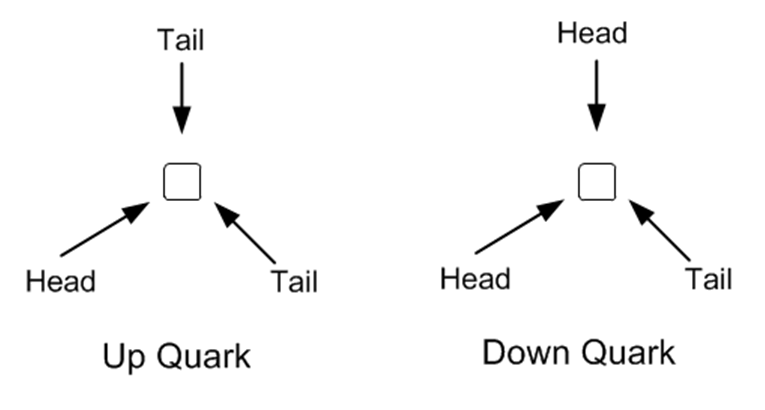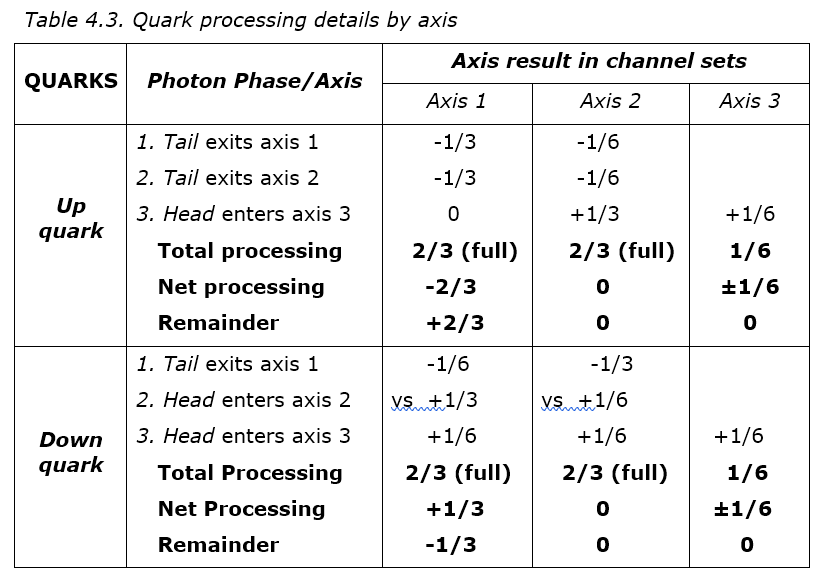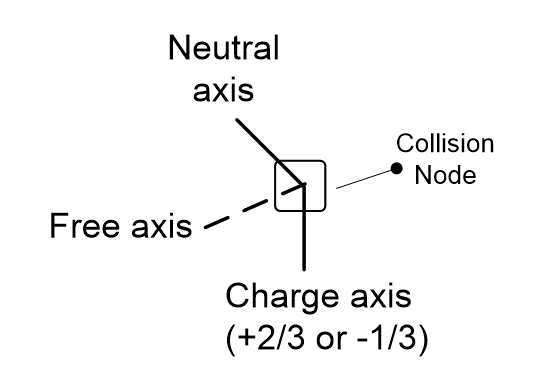A three-axis collision has head-tail phase options just as a one axis collision does. Again, a tail-tail-tail meet isn’t possible as it implies a prior head-head-head event, so the options are:
1. Head-head-head. Three sets of photon heads meeting at equal angles in a point will allocate processing equally, so every axis is only partly filled, leaving free channels that let other entities in from every direction, so this result isn’t stable at all.
2. Head-tail-tail. In this case, two photon sets leave the point as another arrives (Figure 4.10a), so this could be an up quark because two axes are stable, as will be seen.
3. Head-head-tail. In this case, one photon set leaves the point as the other two arrive (Figure 4.10b), so this could be a down quark because two axes are stable, as will be seen.

Figure 4.10 shows the proposed up and down quark structures. Photons compete for channels on a first-come-first-served basis, so the order they meet is important. If a photon head entering a point meets a photon tail leaving it, the tail must have started before the head, or it would be a head, so tails are expected to fill channels first.
Given this, Table 4.3 gives the results for three axes in a plane, where each axis fills at two-thirds not one. Again, if the processing fills the axis bandwidth it is stable, the net processing is mass, and the net remainder is charge.

The details are:
1. Up quark. If two extreme photon sets leave the point as another arrives, the tails first fill one axis, giving a plus two-thirds charge remainder on what can be called its charge axis. The remaining tail photons with later arriving heads then fill a neutral axis, as the remainders cancel. The last photons then partly fill the third free axis to a sixth of its two-thirds capacity. The result has a two-thirds charge, and is stable on two axes but not the third.
2. Down quark. If one photon set is leaving a point as the other two arrive, the tails and heads first fill a neutral axis where the remainders cancel. Then the remaining tails and some heads fill a charge axis, with a minus third charge left over. This again leaves a third free axis partly filled to a sixth instead of two thirds. The result has a minus third charge, and is stable on two axes but not the third.
This structure derives the correct charges for quarks, which other models don’t, as the standard model just allocates quark charges after the fact. Quarks then exist at a point like electrons, but occupy the channels of a plane not a line. In Figure 4.11, the three quark axes are:
1. Charge axis. Fills with charge of +⅔ for an up quark, and -⅓ for a down quark.
2. Neutral axis. Fills with no charge as heads and tails cancel with no remainder.
3. Free axis. Remaining one sixth of head photons partly fills this axis.

Note the photons meet at 120° but the quark axes are at 60° because as head-tail mixes, some rays are leaving as others arrive.
This structure isn’t fully stable so quarks can’t exist alone, but filling two of three axes makes them semi-stable, so they can be stable in a group that arranges to present a stable axis exterior, and quarks in a group are stable. Yet quarks are fully stable in a nucleus, so how do they fill all the channels of a plane? Physics calls the link between quarks the strong force.